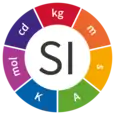Minute
The minute is a unit of time usually equal to 1⁄60 (the first sexagesimal fraction[1]) of an hour, or 60 seconds. In the UTC time standard, a minute on rare occasions has 61 seconds, a consequence of leap seconds (there is a provision to insert a negative leap second, which would result in a 59-second minute, but this has never happened in more than 40 years under this system). Although not an SI unit, the minute is accepted for use with SI units.[2] The SI symbol for minute or minutes is min (without a dot). The prime symbol is also sometimes used informally to denote minutes of time.[3]
History
Al-Biruni first subdivided the hour sexagesimally into minutes, seconds, thirds and fourths in 1000CE while discussing Jewish months.[4] Around 1235 John of Sacrobosco continued this tradition, although Oxford University historian Philipp Nothaft thought Sacrobosco was the first to do so.[5]
Historically, the word "minute" comes from the Latin pars minuta prima, meaning "first small part". This division of the hour can be further refined with a "second small part" (Latin: pars minuta secunda), and this is where the word "second" comes from. For even further refinement, the term "third" (1⁄60 of a second) remains in some languages, for example Polish (tercja) and Turkish (salise), although most modern usage subdivides seconds by using decimals. The symbol notation of the prime for minutes and double prime for seconds can be seen as indicating the first and second cut of the hour (similar to how the foot is the first cut of the yard or perhaps chain, with inches as the second cut). In 1267, the medieval scientist Roger Bacon, writing in Latin, defined the division of time between full moons as a number of hours, minutes, seconds, thirds, and fourths (horae, minuta, secunda, tertia, and quarta) after noon on specified calendar dates.[6] The introduction of the minute hand into watches was possible only after the invention of the hairspring by Thomas Tompion, an English watchmaker, in 1675.[7]
Notes and references
- "What is the origin of hours, minutes and seconds?". Wisteme. Archived from the original on 24 March 2012. Retrieved 2011-05-25.
What we now call a minute derives from the first fractional sexagesimal place
. - "Non-SI units accepted for use with the SI, and units based on fundamental constants". Bureau International de Poids et Mesures. Archived from the original on 2014-11-11. Retrieved 2011-05-25.
- The NIST Reference on Constants, Units, Uncertainty. Units outside the SI. Retrieved 8 October 2020.
- Al-Biruni (1879) [1000]. The Chronology of Ancient Nations. Translated by Sachau, C. Edward. pp. 147–149.
- Nothaft, C. Philipp E. (2018), Scandalous Error: Calendar Reform and Calendrical Astronomy in Medieval Europe, Oxford: Oxford University Press, p. 126, ISBN 9780198799559,
Sacrobosco switched to sexagesimal fractions, but rendered them more congenial to computistical use by applying them not to the day but to the hour, thereby inaugurating the use of hours, minutes, and seconds that still prevails in the twenty-first century.
- R Bacon (2000) [1928]. The Opus Majus of Roger Bacon. BR Belle. University of Pennsylvania Press. table facing page 231. ISBN 978-1-85506-856-8.
- Mitman, Carl (1926). "The Story of Timekeeping". The Scientific Monthly. 22 (5): 424–427. Bibcode:1926SciMo..22..424M. JSTOR 7652.
Bibliography
- Henry Campbell Black, Black's Law Dictionary, 6th Edition, entry on Minute. West Publishing Company, St. Paul, Minnesota, 1991.
- Eric W. Weisstein. "Arc Minute." From MathWorld—A Wolfram


